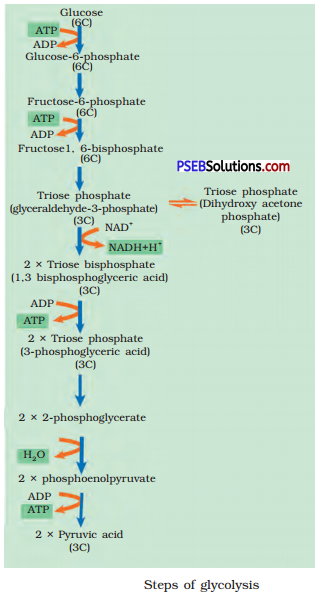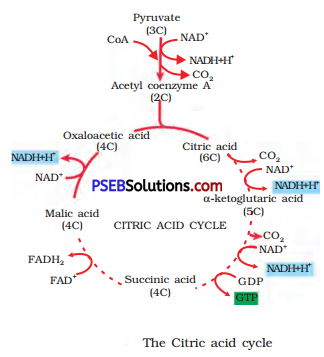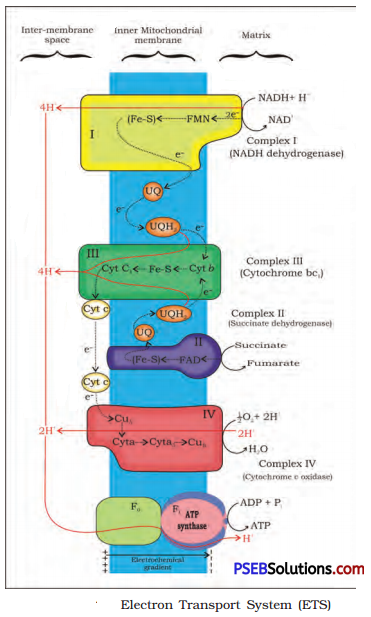Punjab State Board PSEB 11th Class Biology Book Solutions Chapter 14 Respiration in Plants Textbook Exercise Questions and Answers.
PSEB Solutions for Class 11 Biology Chapter 14 Respiration in Plants
PSEB 11th Class Biology Guide Respiration in Plants Textbook Questions and Answers
Question 1.
Differentiate between:
(a) Respiration and Combustion
(b) Glycolysis and Krebs’ cycle
(c) Aerobic respiration and Fermentation
Answer:
(a) Differences between Respiration and Combustion
| Respiration | Combustion |
| 1. It is the breakdown of complex compounds through oxidation within the cells, leading to release of considerable amount of energy. | Combustion is the complete burning of glucose, which produces CO2 and H2O and yields energy which is given out as heat. |
| 2. It is a controlled biochemical process. | It is an uncontrolled physicochemical process. |
| 3. Many chemical bonds break simultaneously by releasing large amounts of energy. | Chemical bonds break one after another to release energy. |
| 4. Enzymes are involved. | Enzymes are not involved. |
(b) Differences between Glycolysis and Krebs’ Cycle
| Glycolysis | Krebs’ Cycle |
| 1. It is also called as Embden Meyerhof-Parnas (EMP) pathway. | It is also known as citric acid cycle or tricarboxylic acid cycle. |
| 2. It occurs in the cytosol of prokaryotes as well as eukaryotes. | In eukaryotes, it occurs in matrix of mitochondria, and in prokaryotes, it occurs in cytoplasm. |
| 3. It starts with the oxidation of glucose. | It starts with the oxidation of pyruvic acid. |
| 4. It is an enzyme-controlled 10 steps process by which glucose, fructose or sucrose is reduced to form pyruvic acid with the production of ATP and NADH2. | It involves 8 steps to oxidize two molecules of acetyl CO-A |
(c) Differences between Aerobic Respiration and Fermentation
| Aerobic Respiration | Fermentation |
| 1. The presence of O2 is required for complete oxidation of organic substances. | Incomplete oxidation of glucose occurs in the absence of oxygen. |
| 2. It releases CO2, water, and a large amount of energy present in the substrate. | Pyruvic acid is converted to CO2 and ethanol and less amount of energy is released. |
| 3. Only two molecules of ATP are produced. | Many molecules of ATP are produced. |
| 4. NADH is oxidized to NAD+ slowly. | This reaction is very vigorous under aerobic respiration. |
![]()
Question 2.
What are respiratory substrates? Name the most common respiratory substrate.
Answer:
The compounds oxidized during the process of respiration are called respiratory substrates. Carbohydrates, especially glucose, act as respiratory substrates. Fats, proteins, and organic acids also act as respiratory substrates.
Question 3.
Give the schematic representation of glycolysis.
Answer:
Glycolysis
- The scheme of reactions was given by Embden, Meycrhof and Pumas, hence it is also called EMP Pathway; it occurs in the cytoplasm of cells.
- In this process, glucose is partially oxidized/ converted into two molecules of pyruvic acid.
- Glucose is phosphorylated with the help of ATP into Glucose-6-Phosphate, catalyzed by the enzyme hexokinase.
- Glucose-6-Phosphate is converted into its isomer, Fructose-6-Phosphate, catalyzed by isomerase.
- Fructose-6-Phosphate is then phosphorylated with the use of ATP into Fructose 1,6-bisphosphate, catalyzed by
phosphofructokinase. - Fructose 1,6-bisphosphate is split into one molecule of 3-pho sphoglyceraldchyd and one molecule of
dihydroxy-acetone phosphate; these two products are interconvertible. - 3-phosphoglyceraldehyde is oxidized to 1, 3 bi phosphoglycerate, where NAD is reduced to NADH.
- 1,3-bisphosphoglycerate is split into 3-phosphoglycerate along with the formation of ATP, catalyzed by phosphoglycerate kinase.

- 3-Phosphoglycerate is subsequently converted into 2-phosphoglycerate and then into Phosphoenol Pyruvate (PEP).
- PEP is converted into pyruvate along with the formation of ATP, catalyzed by the enzyme pyruvate kinase.
In this pathway, ATP molecules are formed in two ways :
- Direct/substrate phosphorylation of ADP to ATP.
- Oxidation of NADH to NAD ’ and ATP formation through electron transport (oxidative phosphorylation).
Four molecules of ATP are formed directly in the following steps:
- When 1, 3 bi phosphoglyceric acids is converted into 3-phosphoglyceric acid and
- When phosphoenolpyruvate is converted into pyruvic acid.
Two molecules of ATP are consumed, one in each of the following steps:
- Phosphorylation of glucose to glucose-6- phosphate and
- Conversion of fructose-6-phosphate into fructose 1, 6 bisphosphates.
When 3-phosphoglyceraldehyde (PGAL) is converted into 1, 3 bi phosphoglycerates, two redox equivalents are removed in the form of two hydrogen atoms from PGAL and transferred to NAD+, which is reduced to NADH + H+.
Oxidation of two molecules of NADH to NAD yields six molecules of ATP during electron transport. The end products of glycolysis are two molecules each of pyruvic acid, NADH, and ATP.
![]()
Question 4.
What are the main steps in aerobic respiration? Where does it take place?
Answer:
The main steps in aerobic respiration are as follows :
- Glycolytic breakdown of glucose into pyruvic acid.
- Oxidative decarboxylation of pyruvic acid to acetyl Co-A (acetyl coenzyme-A).
- Krebs’ cycle.
- Terminal oxidation and phosphorylation in respiratory chain.
It occurs inside the mitochondrial matrix.
Question 5.
Give the schematic representation of an overall view of Kreb’s cycle.
Answer:
Tricarboxylic Acid Cycle or Kreb’s Cycle:
- It is known as tricarboxylic acid cycle, since the first product, citric acid (hence citric acid cycle) is a tricarboxylic acid (has three COOH groups).
- The sequence of reactions in citric acid cycle was first followed by Sir Hans Kreb; hence it is also known as Kreb’s cycle.
- During this cycle of reactions, 3 molecules of NAD and one molecule of FAD are reduced to NADH and FADH respectively.
- Respiration in Plants 115:
- One ATP molecule is produced directly from GTP formed by substrate-level phosphorylation.
The reactions of aerobic oxidation of Pyruvic acid can be summed up as :
Pyruvic acid + 4NAD+ + FAD+ + 2H2O + ADP + Pi → 3CO2 + 4NADH + 4H+ + FADH2 + ATP

Question 6.
Explain ETS.
Answer:
Electron Transport System (ETS):
- ETS occurs in the electron transport particles (ETP) on the inner surface of the inner membrane of mitochondria.
- NADH formed in glycolysis and citric acid cycle are oxidized by NADH-dehydrogenase (complex I) and the electrons are transferred to ubiquinone, via FMN.
- Ubiquinone also receives reducing equivalents via FADH generated during the oxidation of succinate by succinate dehydrogenase (complex II).
- The reduced ubiquinone called ubiquinol is then oxidized by transfer of electrons to cytochrome c, via cytochrome be bc1 -complex (complex III).
- Cytochrome c acts as a mobile carrier between complex III and complex IV.
- Complex IV refers to cytochrome c oxidase complex containing cytochromes a and a3 and two copper centres.
- When the electrons are shunted over the carriers via complex I to IV in the electron transport chain, they are coupled to ATP synthetase (complex V) for the formation of ATP from ADP and IP.
- Oxygen functions as the terminal acceptor of electrons and is reduced to water along with the hydrogen atoms.

Question 7.
Distinguish between the following:
(a) Aerobic respiration and anaerobic respiration.
(b) Glycolysis and fermentation.
(c) Glycolysis and citric acid cycle.
Answer:
(a) Differences between Aerobic and Anaerobic Respiration
| Aerobic Respiration | Anaerobic Respiration |
| 1. Presence of oxygen is essential. | Occurs without oxygen. |
| 2. Complete oxidation of substrates occurs into CO2 and H2O. | Incomplete degradations of substrates. |
| 3. End products are non-toxic. | End products are toxic when accumulated in large amount. |
| 4. Involves glycolysis, Krebs’ cycle, and terminal oxidation. | Involves only glycolysis followed by incomplete breakdown of pyruvic acid. |
| 5. 36 ATP molecules are produced from each glucose molecule. | Only two molecules of ATP are produced from each glucose molecule. |
(b) Differences between Glycolysis and Fermentation:
| Glycolysis | Fermentation |
| 1. it occurs in cytoplasm of the cell and in all living things. | it occurs in yeast and muscle cells in animals when oxygen is not sufficient for cellular respiration. |
| 2. Glucose undergoes partial oxidation to form two molecules of pyruvic acid. | The enzyme-like pyruvic acid decarboxylase and alcohol dehydrogenase catalyze these reactions. |
| 3. The end products are CO2, H2O and energy. | The end products are CO2 and ethanol and in animal cells lactic acid is released. |
(c) Differences between Glycolysis and Krebs’ Cycle
| Glycolysis | Krebs’ Cycle |
| 1. It is also called as Embden Meyerhof-Parnas (EMP) pathway. | It is also known as citric acid cycle or tricarboxylic acid cycle. |
| 2. It occurs in the cytosol of prokaryotes as well as eukaryotes. | In eukaryotes, it occurs in matrix of mitochondria and in prokaryotes, it occurs in cytoplasm. |
| 3. It starts with the oxidation of glucose. | It starts with the oxidation of pyruvic acid. |
| 4. It is an enzyme-controlled 10 steps process by which glucose, fructose or sucrose is reduced to form pyruvic acid with the production of ATP and NADH2. | It involves 8 steps to oxidize two molecules of acetyl CO-A |
Question 8.
What are the assumptions made during the calculation of net gain of ATP?
Answer:
The calculations of net gain of ATP can be made only on certain assumptions :
- There is a sequential, orderly pathway functioning, with one substrate forming the next and with glycolysis, TCA cycle and ETS pathway following one after another.
- The NADH synthesized in glycolysis is transferred into the mitochondria and undergoes oxidative phosphorylation.
- None of the intermediates in the pathway are utilised to synthesize any other compound.
- Only glucose is being respired-no other alternative substrates are entering in the pathway at any of the intermediary stages.
But this kind of assumptions are not really valid in a living system. All pathways work simultaneously and do not take place one after another. Substrates enter the pathways and are withdrawn from it as end when necessary; ATP is utilized as and when needed; enzymatic rates are controlled by multiple means. In overall steps, there is a net gain of 36 ATP molecules during aerobic respiration of one molecule of glucose.
Question 9.
Discuss ‘the respiratory pathway is an amphibolic pathway.’
Answer:
Aniphibolic Pathway: Glucose is the favored substrate for respiration. All carbohydrates are usually first converted into glucose before they are used for respiration. Other substrates can also be respired but then they do not enter the respiratory pathway at the first step.
Since respiration involves breakdown as well as synthesis of substrates, the respiratory process involves both catabolism and anabolism. That is why respiratory pathway is considered to be an amphibolic pathway rather than as a catabolic one.
Question 10.
Define RQ. What is its value for fats?
Answer:
Respiratory quotient (RQ) or respiratory ratio can be defined as the ratio of the volume of CO2 evolved to the volume of O2 consumed during respiration. The value of respiratory quotient depeñds on the type of respiratory substrate. Its value is one for carbohydrates. However, it is always less than one for fats as fats consume more oxygen for respiration than carbohydrates.
It can be illustrated through the example of tripalmitin fatty acid, which consumes 145 molecules of O2 for respiration while 102 molecules of CO2 are evolved.The RQ value for tripalmitin is 0.7.
Question 11.
What is oxidative phosphorylation?
Answer:
It refers to the formation of ATP in the mitochondria, utilizing the energy obtained by the oxidation of organic molecules.
Question 12.
What is the significance of step-wise release of energy in respiration?
Answer:
During oxidation within a cell, all the energy contained in respiratory substrates is not released free in a single step. It is released in a series of slow step-wise reactions controlled by enzymes and it is trapped as chemical energy in the form of ATP. The significance of this step-wise release of energy is that some energy is used to synthesize ATP. This ATP is stored for the later utilization wherever required. Hence, ATP acts as the energy currency of cell. The energy
stored in ATP can be utilized for following:
- In various energy-requiring processes of organisms.
- The carbon skeleton produced during respiration is used as precursors for the synthesis of other molecules.
